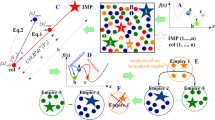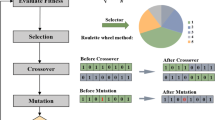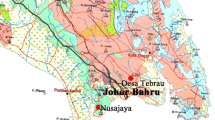Abstract
In this paper, the relationships between engineering properties of travertine rock samples including uniaxial compressive strength, density, Brazilian tensile strength and compressional and shear wave velocities were evaluated. The Bukan travertine mine located in Iran was considered as case study here. Various data analysis approaches including simple regression method, multiple regression method and artificial neural network (ANN) have been used for finding optimum estimation model for uniaxial compression strength of travertine rocks. Rock sample preparations difficulties and conducting expensive tests such as UCS motivated many researchers to study different regression methods to estimate UCS from other rock mechanic tests. In this paper, different statistical methods as well as some ANN optimization algorithms that were used by several researchers are compared to find the optimum solution for UCS estimation problem of travertine rock samples. These optimization tools comprising genetic algorithm, particle swarm optimization and imperialist competitive algorithm were applied to improve the efficiency of ANN analysis. Finally, after comparing all of the presented methods, the best results were obtained by ANN-PSO algorithm.











Similar content being viewed by others
Data availability
The data are available in Appendix 1
Code availability
Not applicable.
References
Horsrud P (2001) Estimating mechanical properties of shale from empirical correlations. Soc Pet Eng. https://doi.org/10.2118/56017-PA
Kahraman S (2001) Evaluation of simple methods for assessing the uniaxial compressive strength rock. International Journal of Rock Mechanics and Mining Sciences 38(7):981–994. https://doi.org/10.1016/s1365-1609(01)00039-9
Yasar E, Erdogan Y (2004) Correlating sound velocity with the density, compressive strength and Young’s modulus of carbonate rocks. Int J Rock Mech Min Sci 41(5):871–875. https://doi.org/10.1016/j.ijrmms.2004.01.012
Yaşar E, Erdoğan Y (2004) Estimation of rock physicomechanical properties using hardness methods. Eng Geol 71(3–4):281–288. https://doi.org/10.1016/s0013-7952(03)00141-8
Chang C, Zoback MD, Khaksar A (2006) Empirical relations between rock strength and physical properties in sedimentary rocks. J Petrol Sci Eng 51(3–4):223–237. https://doi.org/10.1016/j.petrol.2006.01.003
Çobanoğlu İ, Çelik SB (2008) Estimation of uniaxial compressive strength from point load strength, Schmidt hardness and P-wave velocity. Bull Eng Geol Env 67(4):491–498. https://doi.org/10.1007/s10064-008-0158-x
Yagiz S (2008) Predicting uniaxial compressive strength, modulus of elasticity and index properties of rocks using the Schmidt hammer. Bull Eng Geol Env 68(1):55–63. https://doi.org/10.1007/s10064-008-0172-z
Diamantis K, Gartzos E, Migiros G (2009) Study on uniaxial compressive strength, point load strength index, dynamic and physical properties of serpentinites from Central Greece: test results and empirical relations. Eng Geol 108(3–4):199–207. https://doi.org/10.1016/j.enggeo.2009.07.002
Moradian Z, Behnia M (2009) Predicting the uniaxial compressive strength and static Young’s modulus of intact sedimentary rocks using the ultrasonic test. Int J Geomech 9(1):14–19
Minaeian B, Ahangari K (2011) Estimation of uniaxial compressive strength based on P-wave and Schmidt hammer rebound using statistical method. Arab J Geosci 6(6):1925–1931. https://doi.org/10.1007/s12517-011-0460-y
Singh TN, Kainthola A, Venkatesh A (2011) Correlation between point load index and uniaxial compressive strength for different rock types. Rock Mech Rock Eng 45(2):259–264. https://doi.org/10.1007/s00603-011-0192-z
Bruno G, Vessia G, Bobbo L (2012) Statistical method for assessing the uniaxial compressive strength of carbonate rock by Schmidt Hammer tests performed on core samples. Rock Mech Rock Eng 46(1):199–206. https://doi.org/10.1007/s00603-012-0230-5
Azimian A, Ajalloeian R, Fatehi L (2013) An Empirical Correlation of Uniaxial Compressive Strength with P-wave Velocity and Point Load Strength Index on Marly Rocks Using Statistical Method. Geotech Geol Eng 32(1):205–214. https://doi.org/10.1007/s10706-013-9703-x
Jahed Armaghani D, Hajihassani M, Yazdani Bejarbaneh B, Marto A, Tonnizam Mohamad E (2014) Indirect measure of shale shear strength parameters by means of rock index tests through an optimized artificial neural network. Measurement 55:487–498. https://doi.org/10.1016/j.measurement.2014.06.001
Karaman K, Kesimal A, Ersoy H (2014) A comparative assessment of indirect methods for estimating the uniaxial compressive and tensile strength of rocks. Arab J Geosci 8(4):2393–2403. https://doi.org/10.1007/s12517-014-1384-0
Kaya A, Karaman K (2015) Utilizing the strength conversion factor in the estimation of uniaxial compressive strength from the point load index. Bull Eng Geol Env 75(1):341–357. https://doi.org/10.1007/s10064-015-0721-1
Madhubabu N, Singh PK, Kainthola A, Mahanta B, Tripathy A, Singh TN (2016) Prediction of compressive strength and elastic modulus of carbonate rocks. Measurement 88:202–213. https://doi.org/10.1016/j.measurement.2016.03.050
Salehin S (2017) Investigation into engineering parameters of marls from Seydoon dam in Iran. Jo Rock Mech Geotech Eng 9(5):912–923
Salehin S, Hadavandi E, Chelgani SC (2020) Exploring relationships between mechanical properties of marl core samples by a coupling of mutual information and predictive ensemble model. Model Earth Syst Environ 6(1):575–583
Matin S, Farahzadi L, Makaremi S, Chelgani SC, Sattari G (2018) Variable selection and prediction of uniaxial compressive strength and modulus of elasticity by random forest. Appl Soft Comput 70:980–987
Zhang J, Li D, Wang Y (2020) Toward intelligent construction: prediction of mechanical properties of manufactured-sand concrete using tree-based models. J Clean Prod 258:120665
Rabbani E, Sharif F, Koolivand Salooki M (1997) Moradzadeh A (2012) Application of neural network technique for prediction of uniaxial compressive strength using reservoir formation properties. Int J Rock Mech Min Sci 56:100–111
Manouchehrian A, Sharifzadeh M, Moghadam RH (2012) Application of artificial neural networks and multivariate statistics to estimate UCS using textural characteristics. Int J Min Sci Technol 22(2):229–236
Dehghan S, Sattari G, Chelgani SC, Aliabadi M (2010) Prediction of uniaxial compressive strength and modulus of elasticity for Travertine samples using regression and artificial neural networks. Min Sci Technol (China) 20(1):41–46
Yılmaz I, Yuksek A (2008) An example of artificial neural network (ANN) application for indirect estimation of rock parameters. Rock Mech Rock Eng 41(5):781–795
Mishra D, Basu A (2013) Estimation of uniaxial compressive strength of rock materials by index tests using regression analysis and fuzzy inference system. Eng Geol 160:54–68
Karakus M, Tutmez B (2006) Fuzzy and multiple regression modelling for evaluation of intact rock strength based on point load, Schmidt hammer and sonic velocity. Rock Mech Rock Eng 39(1):45–57
Singh R, Umrao RK, Ahmad M, Ansari M, Sharma L, Singh T (2017) Prediction of geomechanical parameters using soft computing and multiple regression approach. Measurement 99:108–119
Sharma L, Vishal V, Singh T (2017) Developing novel models using neural networks and fuzzy systems for the prediction of strength of rocks from key geomechanical properties. Measurement 102:158–169
Motamedi S, Roy C, Shamshirband S, Hashim R, Petković D, Song K-I (2015) Prediction of ultrasonic pulse velocity for enhanced peat bricks using adaptive neuro-fuzzy methodology. Ultrasonics 61:103–113
Kainthola A, Singh P, Verma D, Singh R, Sarkar K, Singh T (2015) Prediction of strength parameters of himalayan rocks: a statistical and ANFIS approach. Geotech Geol Eng 33(5):1255–1278
Singh R, Vishal V, Singh T, Ranjith P (2013) A comparative study of generalized regression neural network approach and adaptive neuro-fuzzy inference systems for prediction of unconfined compressive strength of rocks. Neural Comput Appl 23(2):499–506
Liu Z, Shao J, Xu W, Wu Q (2015) Indirect estimation of unconfined compressive strength of carbonate rocks using extreme learning machine. Acta Geotech 10(5):651–663
Beiki M, Majdi A (1997) Givshad AD (2013) Application of genetic programming to predict the uniaxial compressive strength and elastic modulus of carbonate rocks. Int J Rock Mech Min Sci 63:159–169
Mohamad ET, Armaghani DJ, Momeni E, Abad SVANK (2015) Prediction of the unconfined compressive strength of soft rocks: a PSO-based ANN approach. Bull Eng Geol Env 74(3):745–757
Momeni E, Armaghani DJ, Hajihassani M, Amin MFM (2015) Prediction of uniaxial compressive strength of rock samples using hybrid particle swarm optimization-based artificial neural networks. Measurement 60:50–63
Armaghani DJ, Amin MFM, Yagiz S, Faradonbeh RS, Abdullah RA (2016) Prediction of the uniaxial compressive strength of sandstone using various modeling techniques. Int J Rock Mech Min Sci 85:174–186
Kahraman S, Gunaydin O, Fener M (2005) The effect of porosity on the relation between uniaxial compressive strength and point load index. Int J Rock Mech Min Sci 42(4):584–589
Sharma PK, Singh TN (2007) A correlation between P-wave velocity, impact strength index, slake durability index and uniaxial compressive strength. Bull Eng Geol Env 67(1):17–22. https://doi.org/10.1007/s10064-007-0109-y
Khandelwal M, Singh TN (2009) Correlating static properties of coal measures rocks with P-wave velocity. Int J Coal Geol 79(1–2):55–60. https://doi.org/10.1016/j.coal.2009.01.004
Sarkar K, Vishal V, Singh TN (2011) An empirical correlation of index geomechanical parameters with the compressional wave velocity. Geotech Geol Eng 30(2):469–479. https://doi.org/10.1007/s10706-011-9481-2
Khandelwal M (2012) Correlating P-wave velocity with the physico-mechanical properties of different rocks. Pure Appl Geophys 170(4):507–514. https://doi.org/10.1007/s00024-012-0556-7
Standard A (2008) D2845-08 Standard test method for laboratory determination of pulse velocities and ultrasonic elastic constants of rock. ASTM International, West Conshohocken
ISRM X X (1979) ISRM suggested methods for determining water content, porosity, density, absorption and related properties and swelling and slake-durability index properties. Int J Rock Mechan Min Sci Geomechan Abstr 16(2):143–151
Brown E (1981) Suggested methods for determining the uniaxial compressive strength and deformability of rock materials. Rock characterization, testing and monitoring—ISRM suggested methods. Pergamon Press, Oxford, pp 113–116
Bieniawski Z, Bernede M (1979) Suggested methods for determining the uniaxial compressive strength and deformability of rock materials: part 1. Suggested method for determining deformability of rock materials in uniaxial compression. Int J Rock Mech Min Sci Geomech 2:138–140
Carneiro F (1947) Une novelle methode d’essai pour determiner la Resistance à la traction du beton. Reunion dês Laboratoires d’Essai de Materiaux
Akazawa T (1953) Tension test methods for concretes, international union of testing and research laboratories for-materials and structures (RILEM), Paris. Bulletin 16:11–23
Meulenkamp F, Grima MA (1999) Application of neural networks for the prediction of the unconfined compressive strength (UCS) from Equotip hardness. Int J Rock Mech Min Sci 36(1):29–39
Lee S-C (2003) Prediction of concrete strength using artificial neural networks. Eng Struct 25(7):849–857. https://doi.org/10.1016/s0141-0296(03)00004-x
Yılmaz I, Yuksek AG (2007) An Example of Artificial Neural Network (ANN) application for indirect estimation of rock parameters. Rock Mech Rock Eng 41(5):781–795. https://doi.org/10.1007/s00603-007-0138-7
Tiryaki B (2008) Predicting intact rock strength for mechanical excavation using multivariate statistics, artificial neural networks, and regression trees. Eng Geol 99(1–2):51–60
Singh R, Vishal V, Singh TN, Ranjith PG (2012) A comparative study of generalized regression neural network approach and adaptive neuro-fuzzy inference systems for prediction of unconfined compressive strength of rocks. Neural Comput Appl 23(2):499–506. https://doi.org/10.1007/s00521-012-0944-z
Simpson PK (1990) Artificial neural system—foundation, paradigm, application and implementations. Pergamon, New York
Singh TN, Kanchan R, Saigal K, Verma AK (2004) Prediction of P-wave velocity and anisotropic properties of rock using Artificial Neural Networks technique. J Sci Ind Res 63:32–38
Haykin S, Network N (2004) A comprehensive foundation. Neural Netw 2(2004):41
Kaastra I, Boyd M (1996) Designing a neural network for forecasting financial and economic time series. Neurocomputing 10(3):215–236
Masters T (1993) Practical neural network recipes in C++. Morgan Kaufmann
Paola J (1994) Neural network classification of multispectral imagery. Master Tezi, The University of Arizona, USA
Ripley BD (1993) Statistical aspects of neural networks. Networks and chaos—statistical and probabilistic aspects 50:40-123
Wang C (1994) A theory of generalization in learning machines with neural network applications
Demuth H, Beale M (1993) Neural network toolbox for use with matlab–User’S guide verion 3.0
Majdi A, Beiki M (2010) Evolving neural network using a genetic algorithm for predicting the deformation modulus of rock masses. Int J Rock Mech Min Sci 47(2):246–253. https://doi.org/10.1016/j.ijrmms.2009.09.011
Atashpaz-Gargari E, Lucas C (2007) Imperialist competitive algorithm: an algorithm for optimization inspired by imperialistic competition. In: IEEE congress on evolutionary computation, 2007. CEC 2007. IEEE, pp 4661–4667
Wang H, Pan J, Wang S, Zhu H (2015) Relationship between macro-fracture density, P-wave velocity, and permeability of coal. J Appl Geophys 117:111–117. https://doi.org/10.1016/j.jappgeo.2015.04.002
Teng J, Yao Y, Liu D, Cai Y (2015) Evaluation of coal texture distributions in the southern Qinshui basin, North China: investigation by a multiple geophysical logging method. Int J Coal Geol 140:9–22. https://doi.org/10.1016/j.coal.2014.12.014
Kassab MA, Weller A (2015) Study on P-wave and S-wave velocity in dry and wet sandstones of Tushka region, Egypt. Egypt J Petrol 24(1):1–11. https://doi.org/10.1016/j.ejpe.2015.02.001
El Sayed NA, Abuseda H, Kassab MA (2015) Acoustic wave velocity behavior for some Jurassic carbonate samples, north Sinai, Egypt. J Afr Earth Sci 111:14–25
Heidari M, Momeni AA, Naseri F (2013) New weathering classifications for granitic rocks based on geomechanical parameters. Eng Geol 166:65–73. https://doi.org/10.1016/j.enggeo.2013.08.007
Lee J-S, Yoon H-K (2017) Characterization of rock weathering using elastic waves: a Laboratory-scale experimental study. J Appl Geophys 140:24–33. https://doi.org/10.1016/j.jappgeo.2017.03.008
Funding
Not applicable.
Author information
Authors and Affiliations
Contributions
Mr. Salehin did the analysis and wrote the article, Dr. Khorasani revised the article, Mr. Ebdali did some of laboratory tests.
Corresponding author
Ethics declarations
Conflict of interest
Not applicable.
Appendix
Appendix
See Table 12.
Rights and permissions
About this article
Cite this article
Ebdali, M., Khorasani, E. & Salehin, S. A comparative study of various hybrid neural networks and regression analysis to predict unconfined compressive strength of travertine. Innov. Infrastruct. Solut. 5, 93 (2020). https://doi.org/10.1007/s41062-020-00346-3
Received:
Accepted:
Published:
DOI: https://doi.org/10.1007/s41062-020-00346-3




